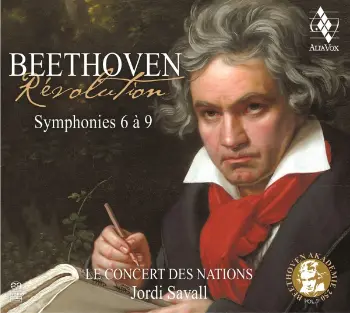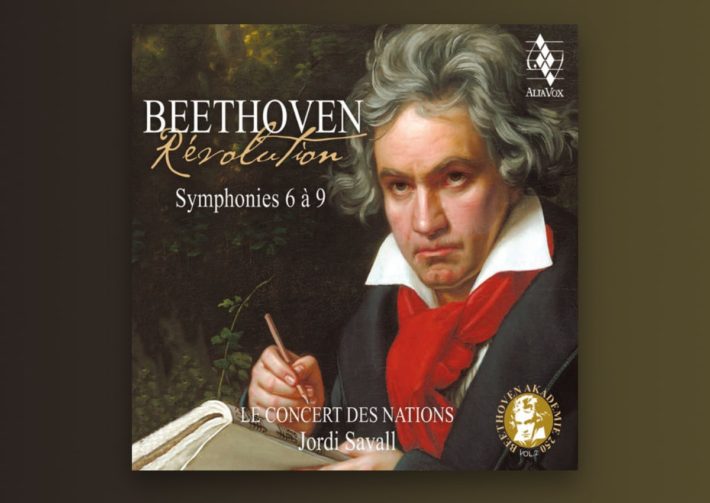In August 2020 I wrote an enthusiastic review of the first volume in this series. As with so many other recording projects, Covid disrupted its completion. But, with a keen determination, Savall and his musicians finished the cycle, recording the sixth and seventh symphonies in July 2020, the eighth in October 2020, and the ninth a year later. The CD booklet includes several pictures of the musicians masked and spaced out, as well as Savall’s description of difficulties encountered in completing the recording (including four choir members contracting Covid a day before the ninth was originally scheduled to be recorded). Surely those circumstances, and this group’s efforts to overcome them, are a key ingredient to the success of these recordings, with performances just as impressive as those heard in Volume I.

Check offers for this album on Amazon
The orchestral playing in all four symphonies is stupendous. In his notes Savall explains that several preparatory “academies” were held where 35 Le Concert des Nations players worked alongside 20 young players from all over Europe. Each symphony was allotted a great deal of rehearsal time, including sectionals, and the results of such careful rehearsing are plain evident in these recording.
As in the previous volume, the heterogeneous pungency of the sound, especially in the strings (recorded quote closely) is distinctive. The contrabass section has a presence that adds tangible depth and richness to the overall orchestral sound. Timpani are a tad less prominent compared to the first volume, though they still have tremendous impact (sample the storm music of the sixth and the ninth’s scherzo). Woodwinds display vim and vigor in faster music, and lovely lyricism in slow movements. The bird calls at the end of “Scene by the brook” are incredibly evocative and listen to how playfully the winds interact in the second movement of the eighth. Brass has plenty of gruff power at climaxes, but I was more taken with how often their playing added special color and drive to the music (listen to the horn’s ‘chortle’ in the trio of the seventh, their foot stomping revelry in the sixth’s merry folk dance, followed by the thrilling snarl of the entire brass in the storm. This is playing of passionate intensity, great beauty, and sonorous character.
The Ninth Symphony has often been the Achilles heel of period instrument cycles. A glance at Savall’s timings before listening suggested he sees this work as still deeply rooted in the Classical period, but hearing the performance suggests otherwise. The opening movement has a relentless agitation, followed by a Scherzo where any sense of joy feels hard won. The slow movement will surely strike some as too fast (of course Savall is following Beethoven’s metronome markings), yet I never once felt emotionally shortchanged, such is the vibrancy and passion of the playing. The final movement’s explosive dissonant chord yanks the listener back into conflict, the lower string recitative that follows restlessly questioning. The introduction of the ‘Ode to Joy’ theme is gentle, the orchestral variations building inexorably towards joy until the opening dissonant chord rudely disrupts the musical argument.
Baritone Manuel Walser’s opening solo packs a wallop (did the engineers spot-lite this entrance? If so, why? It is the only moment in these recordings that seems artificially engineered). His three colleagues are just as impressive: how well-balanced they are, in both size and (minimal) vibrato – these four really listen to one another. Articulation, textual clarity, and blend are superb. The same is true of the choir, again mixing Savall’s normal choir with young singers from around Europe. They make Beethoven’s taxing writing seem deceptively easy and are clearly intent on expressing Schiller’s words. The final orchestral coda, which often lacks impact with period instruments, has tremendous weight and power.
All but the eighth symphony were recorded in orchestra’s usual recording venue, Collégiale du Château de Cardona (Catalogne). Despite the generous acoustic, the sound has startling immediacy. In the eighth, recorded at the National Forum of Music in Wroclaw, Poland, the orchestra sounds a tad more recessed, with a less generous acoustic.
Some reviewers have proclaimed this their favorite Beethoven cycle. Despite my enthusiasm, this is a statement I am not prepared to make. The genius of Beethoven’s music cannot be fully revealed in any one cycle. Nor would I ever want to limit myself to one sound ‘profile:’ despite being an ardent proponent of historically informed performances and period instruments, there are times when I want to hear the luxurious power and refinement of Karajan’s Berlin Philharmonic, or the sophisticated elegance of Jarvi’s cycle with the Deutsche Kammerphilharmonie Bremen. Norrington’s first cycle with the London Classical Players, one of the first on period instruments, has a zealotry that is almost impossible to equal, even though some of Norrington’s ideas now seem wrongheaded. That these works can offer up their intellectual and emotional truths in performances of such widely differing approaches is but one sign of just how brilliant they are. And now Savall has given us a new, deeply considered, wonderfully vibrant and emotionally transforming set of the symphonies that is absolutely life affirming.

Beethoven – Symphonies Nos. 6-9
Sara Gouzy – Soprano
Laila Salome Fischer – Mezzo-Soprano
Mingjie Lei – Tenor
Manuel Walser – Baritone
La Capella Nacional de Catalunya
Le Concert des Nations
Jordi Savall – Conductor
Alia Vox, CD AVSA9946

Check offers for this album on Amazon

















